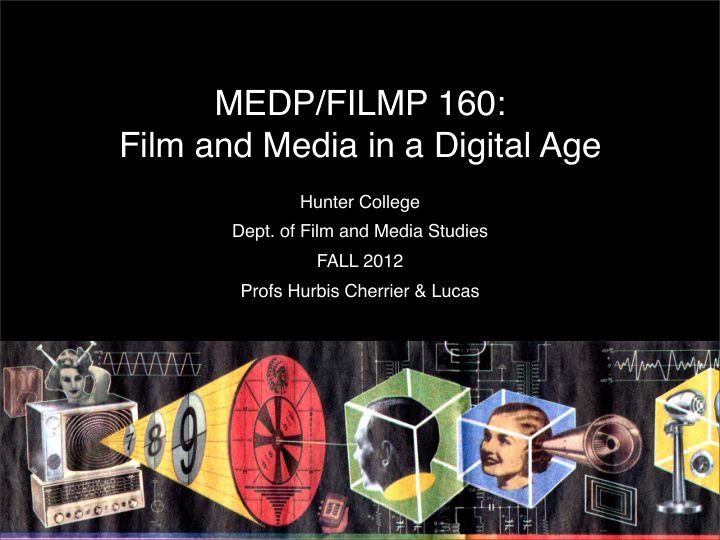



MEDP/FILMP 160: Film and Media in a Digital Age Hunter College Dept. of Film and Media Studies FALL 2012 Profs Hurbis Cherrier & Lucas
Camera plus film... ... a mechanical and a chemical medium
• The motion picture camera owes its origins to a variety of previous inventions…
The Camera Obscura • Camera Obscura means “Dark Chamber”. A hole in the wall allowed light to ‘paint a picture’ inside the room.
A Painter’s Tool • Painters began using the “camera obscura’ • during the Renaissance to help create ‘realistic’ images for new patrons. “View of Delft” by Vermeer c.1660 View of Delft Today...
Adding a Lens makes the unit portable and the image size adjustable • Artist Using a Portable ‘Camera Obscura’
The Magic Lantern Adding a light source to the Camera Obscura meant both a reversal of its logic, and a new form of entertainment. Here we see a Magic Lantern man with his projector.
The Sewing Machine! Mass Production & Repetitive Motion were developed in late 19th Century Devices such as the Sewing Machine, the Typewriter and the Repeating Rifle led to the production capability needed to make the movie camera.
Victorian optical toys Thaumatrope Zoetrope
The Zoetrope This device was one of many 19th century toys to take advantage of “SHORT RANGE APPARENT MOTION”
The Invention of Film In the late 1830’s the development of a science of chemistry meant that inventors in England and France were able to use the properties of SILVER NITRATE to create images with light.
Talbot was an artist who used a ‘camera obscura’ as a drawing aid and made some of the first photographs. For him, film, even without a camera, was also an alternative to his sketchbook.
Eadward Muybridge Muybridge was a photographer who got involved in a settling a question for former California governor and race horse owner Leland Stanford. “Did all four hooves of the horse leave the ground in running, or did one stay in touch?
• In the late 1870s Muybridge invented a special high-speed shutter and a system of multiple cameras with strings that the horse would trip while galloping.
• While Muybridge never animated his images himself, his work is considered a predecessor of both film and animated moving image making.
Edison’s Kinetoscope 1891
Lumiere’s movie camera - 1895
The Flip Book • A modern version of the zoetrope is the ‘flip book’, a short animated story designed to be watched by thumbing through it very quickly.
Clip from Pioneers of Cinema
20
how film cameras work link
how the camera gate works
the film shutter
24
frame rate • flip book = 10 fps • early film cameras = 16 fps • modern cameras = 24 fps • video = 30 fps (NTSC)
double vs. single system sound
The Portapak -1968 First easy-to-use and fairly portable alternative to film...
DIGITAL VIDEO Electronic binary data processing 30 frames per second (29.97 fps)
The CCD
Light-lens-CCD-voltage-data-storage Light-lens-CCD-voltage-data-storage Light-lens-CCD-voltage-data-storage Light-lens-CCD-voltage-data-storage Light-lens-CCD-voltage-data-storage Light-lens-CCD-voltage-data-storage
COLOR SPACE = YRB Y = Green + Luminance R = Red B = Blue LUMINANCE = Brightness (B&W) CHROMINANCE = Color Information (Red, Green, Blue)
INTERLACED SCANNING
How Big is a Frame? Standard Def video 720 x 486 pixels Hi Def video 1280 x 720 1920 x 1080px
1
“uncompressed video”
File Compression
Compression • Storage method that involves eliminating redundant information to reduce file size • Various “codecs” exist to do this
Digital video formats • TAPE-BASED • Mini-DV • DV-Cam FILE-BASED • DVC-Pro AVCHD • DigiBeta P2 XDcam
time code
video standards (SD) NTSC = 525 lines at 30 frames per second PAL = 625 at 25 frames per second.
48
Recommend
More recommend